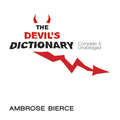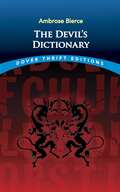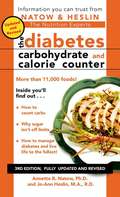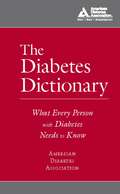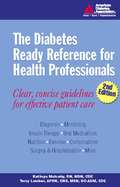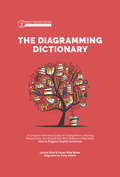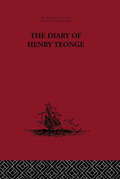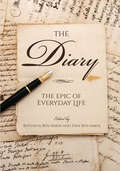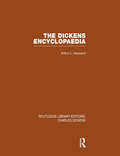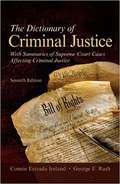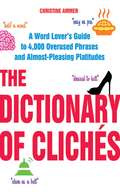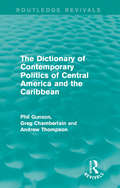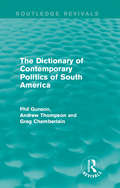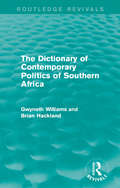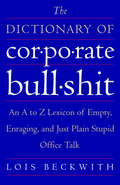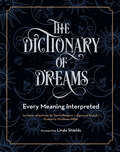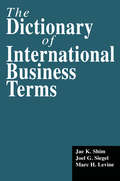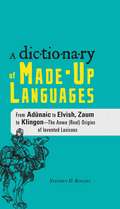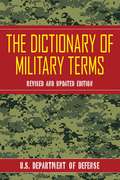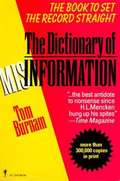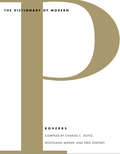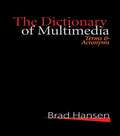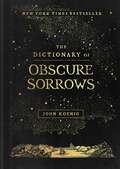- Table View
- List View
The Devil's Dictionary: Complete & Unabridged
by Ambrose Bierce"Bore: A person who talks when you wish him to listen." "Lawyer: One skilled in circumvention of the law." "Positive: Mistaken at the top of one's voice." These and more than 1,000 other comic definitions appear in Ambrose Bierce's wicked satire of conventional dictionaries. An ideal gift for lovers of language, this classic of American humor features a wealth of quips praised by H. L. Mencken as "some of the most gorgeous witticisms in the English language."
The Devil's Dictionary: Satirical Dictionary (Dover Thrift Editions #0)
by Ambrose BierceBorn in Ohio in 1842, journalist, short-story writer and critic Ambrose Bierce developed into one of this country's most celebrated and cynical wits--a merciless "American Swift" whose literary barbs were aimed at folly, self-delusion, politics, business, religion, literature and the arts. In this splendid "dictionary" of epigrams, essays, verses and vignettes, you'll find over 1,000 pointed definitions, e.g. Congratulation ("The civility of envy"), Coward ("One who in a perilous emergency thinks with his legs") and Historian ("A broad-gauge gossip"). Anyone who likes to laugh will love The Devil's Dictionary. Anyone looking for a bon mot to enliven their next speech, paper or conversation will have a field day thumbing through what H. L. Mencken called "some of the most gorgeous witticisms in the English language."
The Diabetes Carbohydrate and Calorie Counter (3rd edition)
by Annette B. Natow Jo-Ann Heslin Karen J. NolanThe revised and updated 3rd edition of one of the first diabetes nutrition books features even more entries and more up-to-date advice than ever.
The Diabetes Dictionary
by American Diabetes AssociationDiabetes can be a complicated disease, and it is sometimes described with complex terms. To stay healthy, you need to understand the constantly growing vocabulary of diabetes research and treatment. The Diabetes Dictionary gives you the straightforward definitions of diabetes terms and concepts that you need to successfully manage your disease. With more than 500 entries, this pocket-size book is an indispensable resource for every person with diabetes.
The Diabetes Ready Reference for Health Professionals
by Terry Lumber Kathryn MulcahyDiabetes care guidelines, protocols, and facts for all healthy care professionals to apply at the point of care for type 1, type 2, and gestational diabetes; compiled by hospital-based diabetes care experts.
The Diagramming Dictionary: A Complete Reference Tool For Young Writers, Aspiring Rhetoricians, And Anyone Else Who Needs To Understand How English Works (Grammar for the Well-Trained Mind #0)
by Susan Wise Bauer Jessica OttoOn its own or as a supplement to the Grammar for the Well-Trained Mind program, this complete compendium of sentence diagramming rules, complete with illustrated sample diagrams, will become an indispensable guide to diagramming and writing—throughout high school, into college, and beyond. Do you understand what makes good writing "good"? Are you struggling against your words instead of using them to express yourself well? Diagramming a sentence shows you how it is (or isn't) working, and unlocks the door to clear, balanced writing. This handbook from Susan Wise Bauer, author of Grammar for the Well-Trained Mind, walks students through the rules of diagramming, from the simplest sentences to the most complex. Its simple instructions allow you to learn at your own pace, without an instructor. Full of easy-to-understand example diagrams, color-coded for quick recognition, this guide will be a trusted reference tool in your home, office, or school for years to come. For ages 13 and Up.
The Diary of Henry Teonge: Chaplain on Board H.M's Ships Assistance, Bristol and Royal Oak 1675-1679
by Henry TeongeFirst published in 1927. 'This diary is history' The ObserverThis is the first complete published edition of Teonge's Diary. The edition of 1825, besides omitting several passages, contained many faulty transcriptions which have now been corrected for this edition. An intensely human document, enlivened with sketches of the people he met and places he visited, Teonge's Diary is one of the finest accounts of life on board ship in the seventeenth century. When not at sea, Henry Teonge's life was as a parson and this edition of his Diary includes a full inventory for his Parish, providing an excellent source of historical and social information on rural life in the late 1600s.
The Diary: The Epic of Everyday Life
by Dan Ben-Amos Batsheva Ben-AmosThe diary as a genre is found in all literate societies, and these autobiographical accounts are written by persons of all ranks and positions. The Diary offers an exploration of the form in its social, historical, and cultural-literary contexts with its own distinctive features, poetics, and rhetoric. The contributors to this volume examine theories and interpretations relating to writing and studying diaries; the formation of diary canons in the United Kingdom, France, United States, and Brazil; and the ways in which handwritten diaries are transformed through processes of publication and digitization. The authors also explore different diary formats, including the travel diary, the private diary, conflict diaries written during periods of crisis, and the diaries of the digital era, such as blogs. The Diary offers a comprehensive overview of the genre, synthesizing decades of interdisciplinary study to enrich our understanding of, research about, and engagement with the diary as literary form and historical documentation.
The Dickens Encyclopaedia: Routledge Library Editions: Charles Dickens Volume 8 (Routledge Library Editions: Charles Dickens #Vol. 8)
by Arthur L. HaywardThis is the standard reference guide to the works of Charles Dickens. The material is arranged alphabetically, in dictionary style, and provides a quick means of reference to the plots of the novels and to all the characters and places mentioned in the novels. There are also useful explanatory notes on allusions and phrases.
The Dictionary Of Criminal Justice
by George Rush Connie IrelandThe Dictionary of Criminal Justice, Seventh Edition, brings together in one, easy-to-use guide more than 3,600 definitions from the many disciplines that compose the field of criminal justice―including U.S. and English common law, penology, psychology, law enforcement, political science, and business administration. The volume also features summaries of nearly 1,000 key U.S. Supreme Court rulings affecting criminal justice, an appendix of juried academic journals, and a new appendix compilation of websites in the field. Links to CRIMINAL JUSTICE websites are included
The Dictionary of Clichés: A Word Lover's Guide to 4,000 Overused Phrases and Almost-Pleasing Platitudes
by Christine AmmerThe largest, most comprehensive, and most entertaining reference of its kind, The Dictionary of Clichés features more than four thousand unique clichés and common expressions. Author Christine Ammer explores the phrases and terms that enliven our language and uncovers expressions that have long been considered dead. With each entry, she includes a thorough definition, origin of the term, and an insightful example.Some of the clichés brought into the limelight include: Blood is thicker than water Monkey see, monkey do Brass tacks Burn the midnight oil Change of heart Moral fiber By the bookWhether clichés get under your skin or make you happy as a clam, The Dictionary of Clichés goes the extra mile to provide an essential resource for students, teachers, writers, and anyone with a keen interest in language. And that's food for thought.
The Dictionary of Contemporary Politics of Central America and the Caribbean (Routledge Revivals: Dictionaries of Contemporary Politics)
by Andrew Thompson Phil Gunson Greg ChamberlainFirst published in 1991, The Dictionary of Contemporary Politics of Central America and the Caribbean provides a guide to the most important organizations, figures, events and themes in the contemporary politics of Central America, Mexico, and the Caribbean. The countries covered include Mexico, Guatamala, Belize, Honduras, El Salvador, Nicaragua, Costa Rica, Panama, Cuba, Dominican Republic, Haiti, Jamaica, Trinidad and Tobago, Barbados, Grenada, St Vincent, St Lucia, Dominica, St Kitt’s-Nevis, Antigua and Puerto Rico. The background information supplied in the book explains how, for many in Central America, the guerrilla wars have merely been the intensification of a conflict previously fought by the likes of Nicaragua’s Sandino or the Salvadorean Farabundo Marti, and before them by the Indian leaders who resisted the Spanish settlement. Although first published in 1991, this book will be a valuable resource for journalists, students, diplomats, business people, and anyone else who is interested in the politics of this richly diverse continent.
The Dictionary of Contemporary Politics of South America (Routledge Revivals: Dictionaries Of Contemporary Politics Ser.)
by Phil GunsonFirst published in 1989, The Dictionary of Contemporary Politics of South America provides a guide to the most important organizations, figures, events and themes in the contemporary politics of South America. The countries covered are Colombia, Venezuela, Ecuador, Bolivia, Peru, Chile, Argentina, Paraguay, Uruguay, Brazil, Suriname and Guyana, as well as the French overseas department of French Guiana. Central American and Caribbean affairs are also touched on when they have implications for South American politics. Taking a broad definition of the term ‘contemporary’, the authors isolate the strands of recent history which have a continual influence on political thinking. Although first published in 1989, this book will be a valuable resource for journalists, students, diplomats, business people, and anyone else who is interested in the politics of this richly diverse continent.
The Dictionary of Contemporary Politics of Southern Africa (Routledge Revivals: Dictionaries of Contemporary Politics)
by Gwyneth Williams Brian HacklandFirst published in 1988, The Dictionary of Contemporary Politics of Southern Africa provides a guide to the often confusing politics of Southern Africa. The book identifies and explains political figures, organisations, systems and terminology from the region in a clear and practical way. It covers eleven countries: Angola, Botswana, Lesotho, Malawi, Mozambique, Namibia, South Africa, Swaziland, Tanzania, Zambia and Zimbabwe. Although first published in 1988, this book will be a valuable resource for journalists, students, diplomats, business people, and anyone else who is interested in the politics of this richly diverse continent.
The Dictionary of Corporate Bullshit: An A to Z Lexicon of Empty, Enraging, and Just Plain Stupid Office Talk
by Lois BeckwithThis caustically funny Webster's of the workplace cuts to the true meaning of the inane argot spouted in cubicles and conference rooms across the land. At a price even an intern can afford and in a handy paperback format that won't weigh down your messenger bag or briefcase, The Dictionary of Corporate Bullshit is a hilarious guide to the smoke-screen terms and passive-aggressive phrases we traffic in every day. Each entry begins with a straight definition followed by a series of alternative meanings that are, of course, what is really meant.Take, for example, the widely used, seemingly innocuous term brainstorming:1. to generate ideas as a group in an accepting environment and in a free-form manner2. a supposedly relaxed forum in which no idea is a bad idea - that is, until you generate a bad idea and are met with uncomfortable silence/looks that suggest you are retarded or really uncool/the feeling that you are about to be firedBeyond deciphering corporate commonplaces, you'll learn the PC term for secret Santa (Holiday Harry); why the Blackberry is "most commonly referred to as a 'Crackberry' due to its highly addictive nature"; and that when a co-worker says "Have a good night", they really mean: "this meaningless, seemingly interminable exchange of small talk is now over. I am no longer speaking to you, and will now flee this awkward social situation. Don't even think of asking which way I'm walking."Just remember to read this only at COB (close of business) to avoid being busted (caught idling by your boss).From the Trade Paperback edition.
The Dictionary of Dreams: Every Meaning Interpreted (Complete Illustrated Encyclopedia Ser. #2)
by Quarto Publishing GroupOne of the most definitive books on the subject with more than 15,000 dream symbols to help you decode the meanings behind your nightly musings.The Dictionary of Dreams provides the necessary tools to interpret almost every dream object and its hidden meaning to better understand what your subconscious is telling you.Dreams can be fun and adventurous, but also frightening and distorted, and still again, they can be an endless combination of both. From spitting teeth out (a sign of aging), to creepy, crawly spiders (a sign that one feels like an outsider), dreams can mean much more to us once we learn how to decipher their hidden meanings. Whether positive or negative, The Dictionary of Dreamsgives you all the tools, symbols, and their true meanings to translate our cryptic nightly images.Starting with selections from classic texts like Interpretation of Dreams by Sigmund Freud, the father of psychoanalysis, and 10,000 Dreams Interpreted by Gustavus Hindman Miller, one of the first authors to complete a thorough study of all the symbols that appear in our dream-scape, this updated edition features revisions (such as the addition of cell phones, computers, televisions, and more) of Miller’s original interpretations to bring the book up to speed with our modern life.
The Dictionary of International Business Terms (Glenlake Business Reference Bks.)
by Jae K. Shim Joel G. Siegel Marc H. LevineThe diversity and complexity associated with the increasing globalization and integration of economies require a familiarity with information technology and terminologies associated with international business. The Dictionary of International Business Terms will be valuable to students and professionals in all areas of business who need to keep abreast of this rapidly changing environment. Over 2,000 terms are defined with examples, charts and illustrations. Additional key areas covered include: global accounting and taxation; exports and imports; global trade, law, and regulations; international organizations; international finance, banking, and investments; economic and business strategies; and management of multinational corporations.
The Dictionary of Made-Up Languages: From Elvish to Klingon, The Anwa, Reella, Ealray, Yeht (Real) Origins of Invented Lexicons
by Stephen D RogersCan you converse in Klingon? Ask an Elf the time of day? Greet a speaker of Esperanto? These are among the more than 100 constructed languages you'll find in this book. For each one, author Stephen D. Rogers provides vocabulary, grammatical features, background information on the language and its inventor, and fascinating facts. What's more, easy-to-follow guidelines show you how to construct your own made-up language--everything from building vocabulary to making up a grammar.So pick up this dictionary! In no time, you'll be telling your friends, "Tsun oe nga-hu ni-Na'vi pangkxo a fì-'u oe-ru prrte' lu." ("It's a pleasure to be able to chat with you in Navi.")
The Dictionary of Military Terms
by DefenseThis is the comprehensive, standardized dictionary of military and associated terminology compiled and used by the Department of Defense. Divided into sections, The Dictionary of Military Terms contains all definitions approved for DoD and the North Atlantic Treaty Organization (NATO) use, as well as a complete listing of commonly used abbreviations and acronyms.
The Dictionary of Military Terms
by DefenseThis is the comprehensive, standardized dictionary of military and associated terminology compiled and used by the Department of Defense. Divided into two sections, The Dictionary of Military Terms contains the terms and definitions approved for Department of Defense (DOD) and the North Atlantic Treaty Organization (NATO) use as well as a complete listing of commonly used abbreviations and acronyms. These military and associated terms, together with their definitions, constitute approved terminology for general use by all DOD components.The Dictionary of Military Terms supplements standard English-language dictionaries and standardizes military and associated terminology to improve communication and mutual understanding within the DOD, with other federal agencies, and among the United States and its allies. It is the primary terminology source when preparing correspondence, including policy, strategy, doctrine, and planning documents. This publication applies to the Office of the Secretary of Defense, the Services, the Joint Staff, combatant commands, DOD agencies, and all other DOD components, and covers terms such as:active defensebattle damage assessmentcandidate target listdirected energyevent matrixfootprinthub and spoke distributionmobilizationnonconventional assisted recoveryprotectionretained personnelspecial operationssurvival, evasion, resistance, and escapeweapons readiness stateand more!
The Dictionary of Misinformation
by Tom BurnamA remarkable book that contains enough information to help you win bets the rest of your life.
The Dictionary of Modern Proverbs
by Wolfgang Mieder Fred R. Shapiro Charles Clay Doyle"You can't unring a bell. " "It takes a village to raise a child. " "Life is just a bowl of cherries. " We sometimes think of proverbs as expressions of ancient wisdom, but in fact new proverbs are constantly arising. This unique volume is devoted exclusively to English-language proverbs that originated in the twentieth and twenty-first centuries. The most complete and accurate such collection ever compiled,The Dictionary of Modern Proverbspresents more than 1,400 individual proverbs gathered and researched with the help of electronic full-text databases not previously used for such a project. Entries are organized alphabetically by key words, with information about the earliest datable appearance, origin, history, and meaning of each proverb. Mundane or sublime, serious or jocular, these memorable sayings represent virtually every aspect of the modern experience. Readers will find the book almost impossible to put down once opened; every page offers further proof of the immense vitality of proverbs and their colorful contributions to the oral traditions of today.
The Dictionary of Multimedia 1999: Terms and Acronyms
by Brad HansenThis book is for programmers, graphic artists, writers, video producers, audio engineers, network managers, hardware technicians, and telecommunications professionals who embrace the complex world of digital media and realize the need for a common language in which to communicate with one another.
The Dictionary of Obscure Sorrows
by John KoenigA truly original book in every sense of the word, The Dictionary of Obscure Sorrows poetically defines emotions that we all feel but don&’t have the words to express, until now—from the creator of the popular online project of the same name.Have you ever wondered about the lives of each person you pass on the street, realizing that everyone is the main character in their own story, each living a life as vivid and complex as your own? That feeling has a name: &“sonder.&” Or maybe you&’ve watched a thunderstorm roll in and felt a primal hunger for disaster, hoping it would shake up your life. That&’s called &“lachesism.&” Or you were looking through old photos and felt a pang of nostalgia for a time you&’ve never actually experienced. That&’s &“anemoia.&” If you&’ve never heard of these terms before, that&’s because they didn&’t exist until John Koenig began his epic quest to fill the gaps in the language of emotion. Born as a website in 2009, The Dictionary of Obscure Sorrows has garnered widespread critical acclaim, inspired TED talks, album titles, cocktails, and even tattoos. The Dictionary of Obscure Sorrows &“creates beautiful new words that we need but do not yet have,&” says John Green, bestselling author of The Fault in Our Stars. By turns poignant, funny, and mind-bending, the definitions include whimsical etymologies drawn from languages around the world, interspersed with otherworldly collages and lyrical essays that explore forgotten corners of the human condition—from &“astrophe,&” the longing to explore beyond the planet Earth, to &“zenosyne,&” the sense that time keeps getting faster. The Dictionary of Obscure Sorrows is for anyone who enjoys a shift in perspective, pondering the ineffable feelings that make up our lives, which have far more in common than we think. With a gorgeous package and beautifully illustrated throughout, this is the perfect gift for creatives, word nerds, and people everywhere.
The Dictionary of Science for Gardeners: 6000 Scientific Terms Explored and Explained (Science For Gardeners Ser.)
by Michael AllabyA Library Journal Best Reference Pick of 2015! Every gardener is a scientist. Pollination, native plants, ecology, climatology—these are just a few of the scientific concepts that play a key role in a successful garden. While the ideas are intuitive to many gardeners, they are often discussed in unfamiliar scientific terms. The Dictionary of Science for Gardeners is the first of its kind to provide practical scientific descriptions for gardening terms. Highlighting 16 branches of science that are of particular interest to gardeners, with entries from abaptation to zoochory, Michael Allaby explores more than 6,000 terms in one easy-to-use reference.
